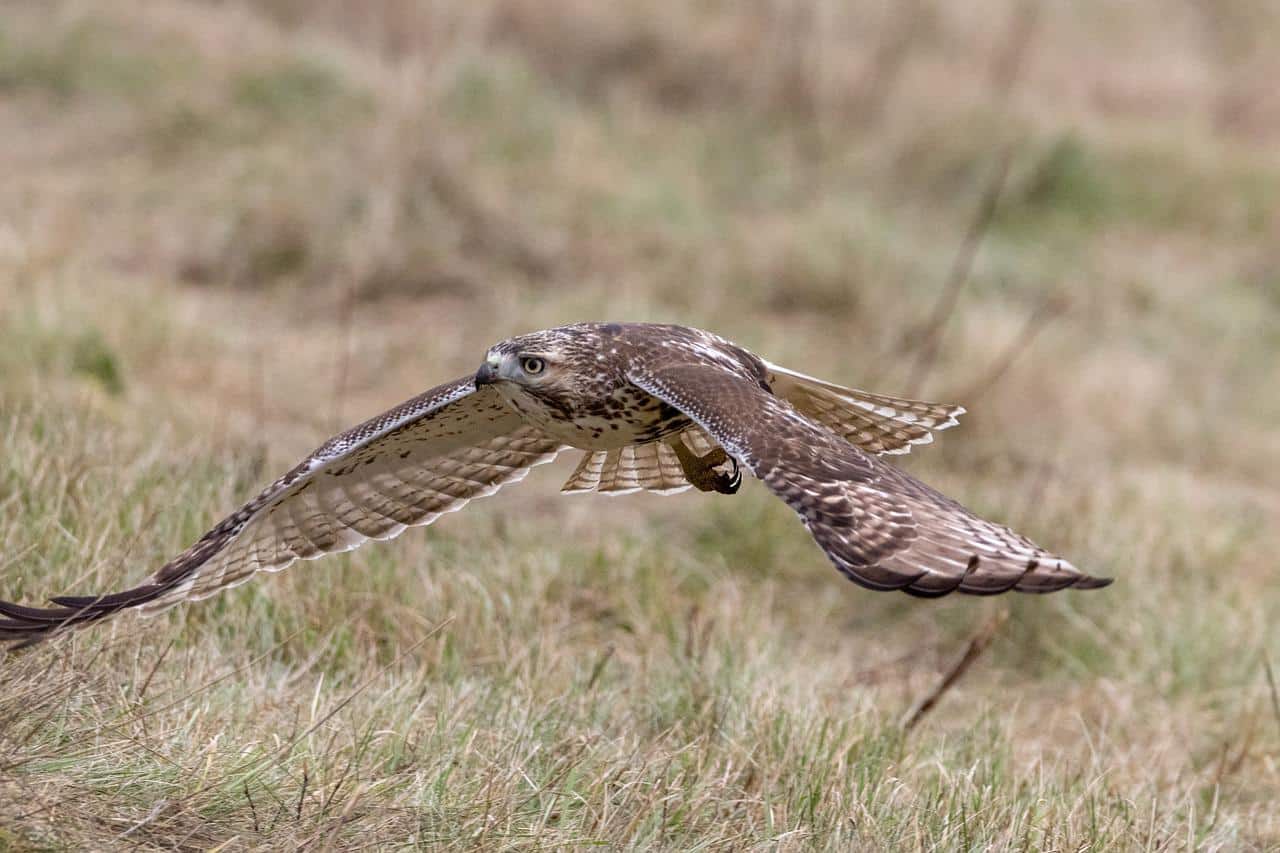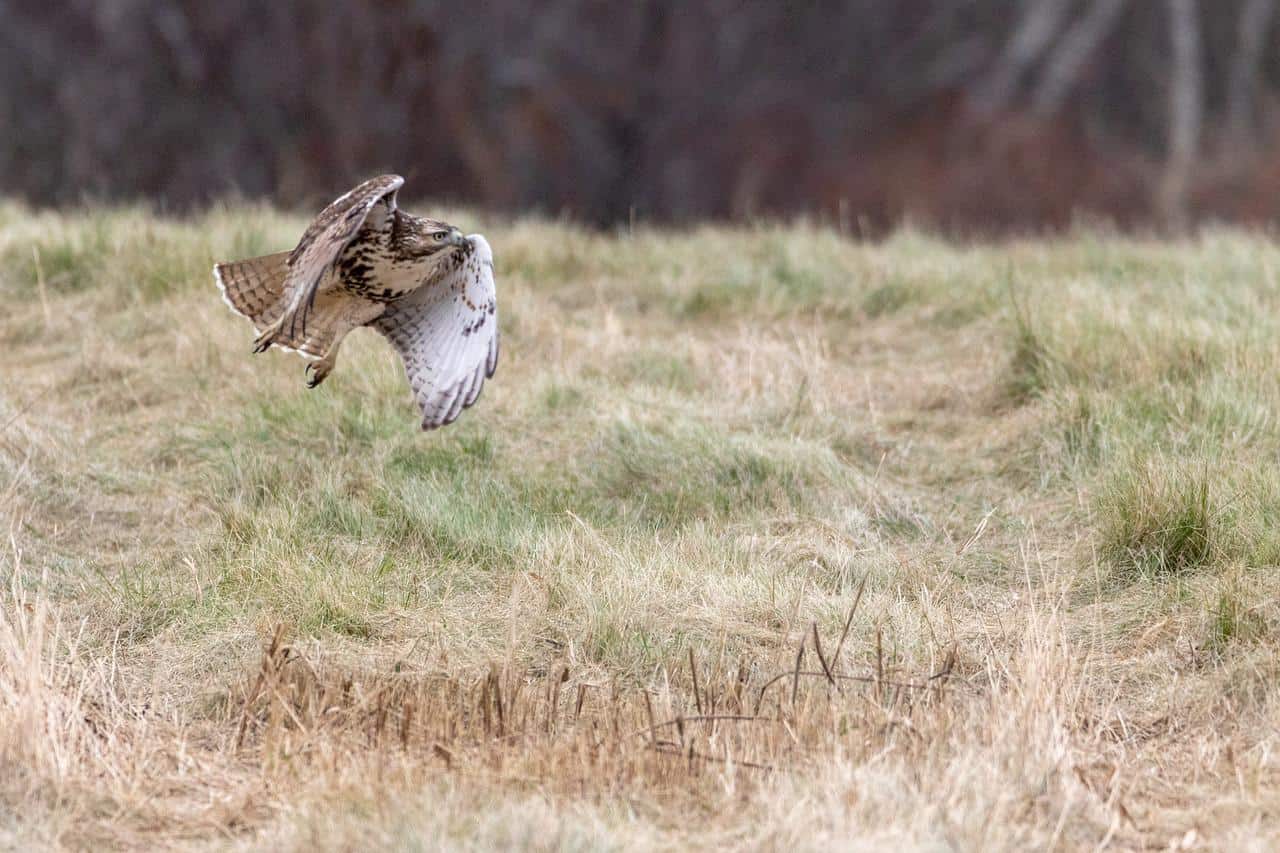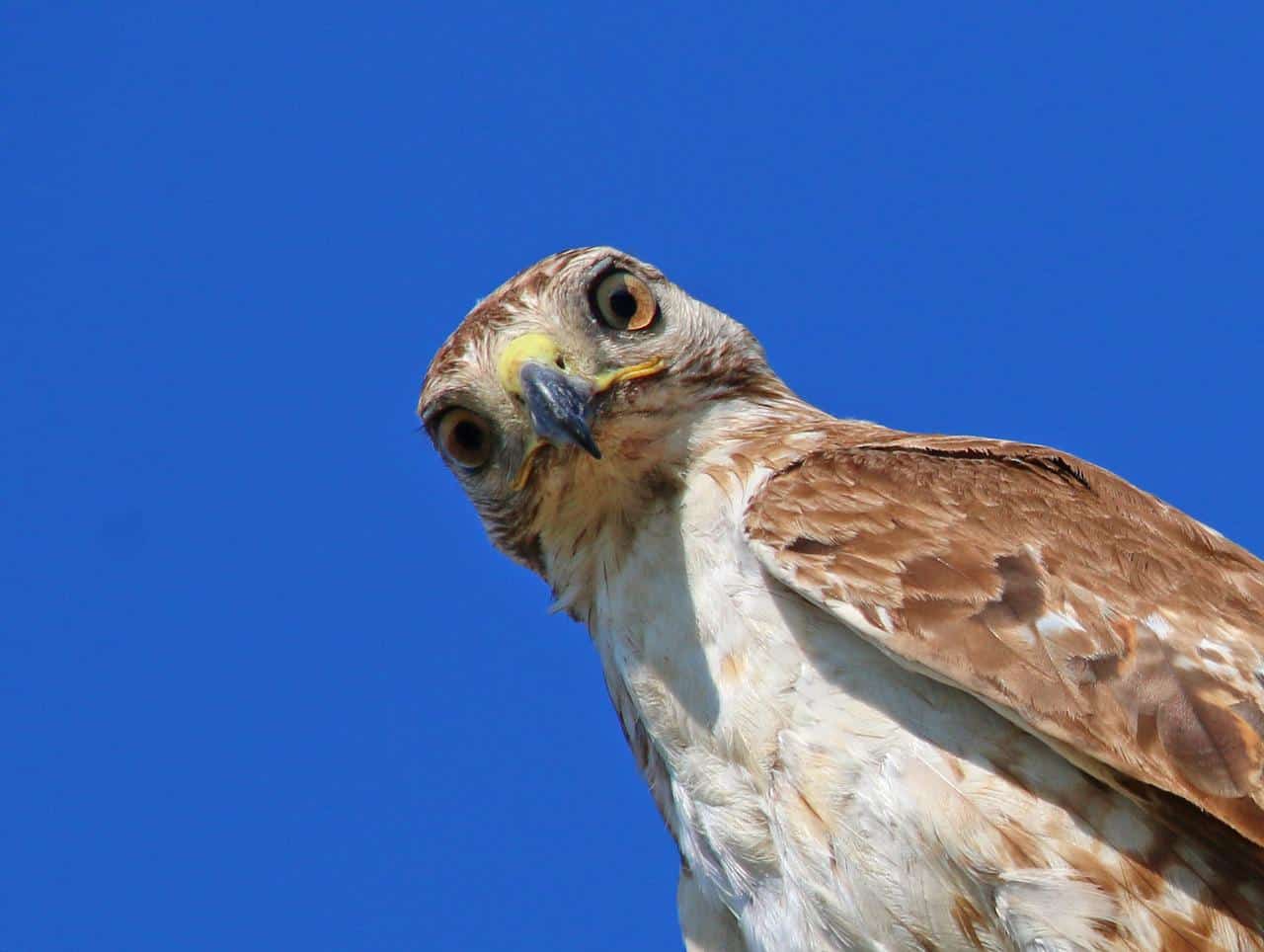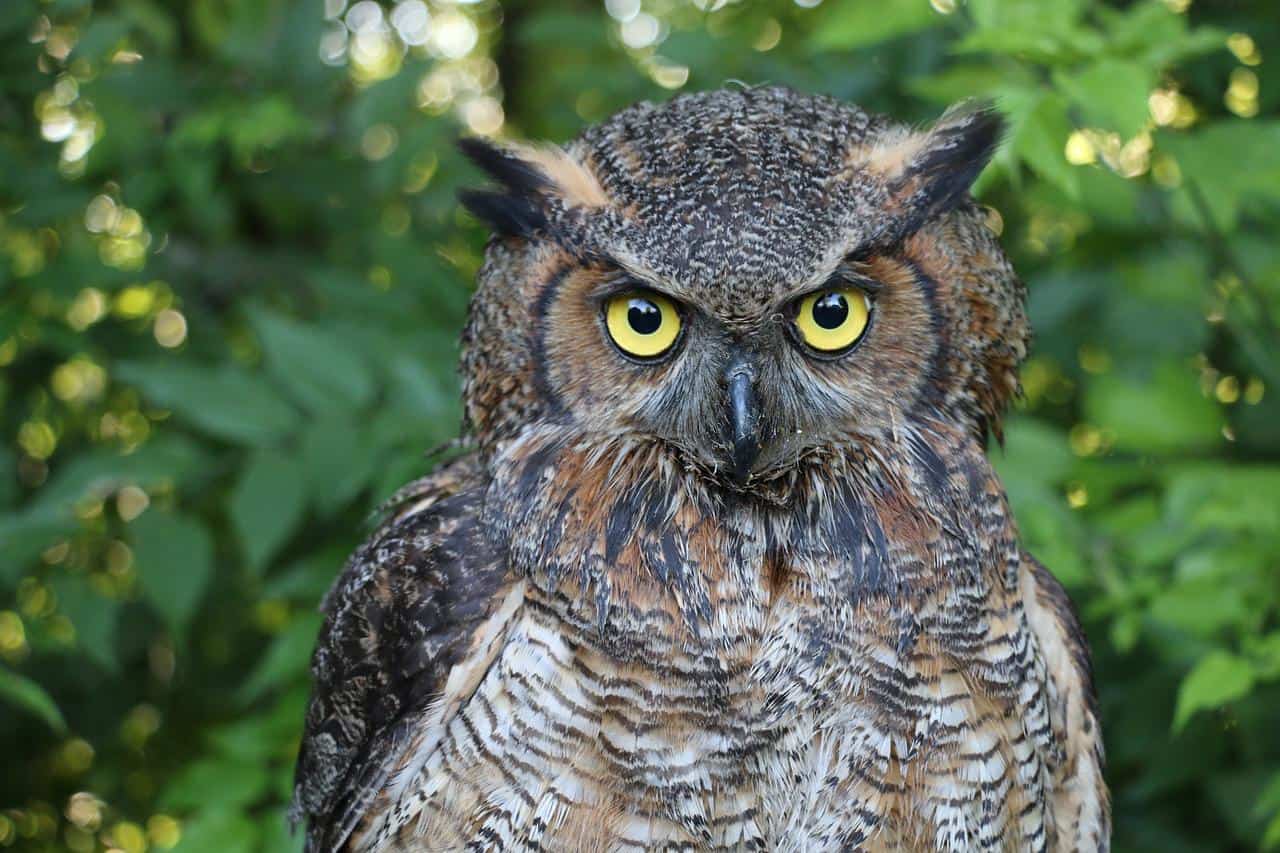- Amethyst-throated Mountain-Gem Guide (Lampornis amethystinus) - November 24, 2022
- Best Martin Bird House Guide - November 14, 2022
- Best Millet Bird Seed Guide - November 9, 2022
Have you ever experienced that quintessential moment when you’re out for a walk or bike ride and hear the loud screeching “kree-aar” of a Red-tailed Hawk? It feels like something out of a movie or television show. Funny enough, this popular call can be heard on TV and in film regularly, but you will rarely see a Red-tailed Hawk.
When used in the media, it is attributed to the Bald Eagle. Although the Bald Eagle is a majestic and iconic symbol of American freedom, its call is not as memorable as the high-pitched scream of the Red-tailed Hawk.
You might have heard this call and scanned the skies hoping to see the once endangered Bald Eagle, but instead saw the most common Hawk in North America. While the Red-tailed Hawk is not any less majestic, America has given great importance to the Bald Eagle, and spotting one is a much rarer occurrence. It’s easy to understand how the misused call creates confusion among people and has led to disappointment.
Taxonomy
The Red-tailed Hawk is a diurnal bird that is classified within the order Accipitriformes along with other birds of prey such as eagles, kites, and vultures. The family Accipitridae is one of three within the order and proudly houses the Red-tailed Hawk. Its genus, Buteo, contains medium-sized raptors and is a term used to describe a soaring bird that is easily recognized for its robust body, broad wings, and short tail.
How to Identify a Red-Tailed Hawk
There are several subspecies of Red-tailed Hawks that can be found across North America, Central America, as well as Caribbean and Pacific islands. This means that the Red-tailed Hawk’s appearance can vary drastically and may be polymorphic in some regions.
The subspecies include:
- Caribbean Red-tailed Hawk – (Buteo jamaicensis jamaicensis)
- Alaskan Red-tailed Hawk – (Buteo jamaicensis alascensis)
- Western Red-tailed Hawk – (Buteo jamaicensis calurus)
- Florida Red-tailed Hawk – (Buteo jamaicensis umbrinus)
- Harlan’s Hawk – (Buteo jamaicensis harlani)
- Eastern Red-tailed Hawk – (Buteo jamaicensis borealis)
- Central American Red-tailed Hawk – (Buteo jamaicensis costaricensis)
- Tres Marias Red-tailed Hawk – (Buteo jamaicensis fumosus)
- Socorro Red-tailed Hawk – (Buteo jamaicensis socorroensis)
- Krider’s Red-tailed Hawk – (Buteo jamaicensis kriderii)
- Mexican Highlands Red-tailed Hawk – (Buteo jamaicensis hadropus)
Size and Shape
According to All About Birds, the Red-tailed Hawk is the second-largest North American Hawk behind the Ferruginous Hawk. This sexually dimorphic species ranges in size, with females being an average of twenty-five percent larger than males.
Females are typically nineteen to twenty-five inches long with a wingspan of forty-five to fifty-two inches. On average, they weigh thirty-two to fifty-two ounces. Males are smaller with a length of seventeen to twenty-two inches, a wingspan of forty-four to fifty-two inches, and weigh in at twenty-four to forty-five ounces. Weights fluctuate between seasons. These birds are at their heaviest during the winter, and during the summer breeding season, they are their lightest weight.
This bird’s buteo shape can be easily seen soaring throughout the sky. Its broad wings, large body, and wide but short tail are the primary indicators that you’re looking at a Red-tailed Hawk.
Color
If you live in North America, the Red-tailed Hawk is the only Hawk on the continent with a short rufous tail. However, the plumage of the Red-tailed Hawk varies greatly across subspecies. Most have a bellyband on their underside that ranges from prominent to subtle. They can also present polymorphic traits. While this makes identifying subspecies a bit tricky, the general components of their plumage and shape are uniform throughout.
Most commonly, a Red-tailed Hawk will have a light brown to deep chocolatey brown body with a creamy white underbelly. Their napes and crowns range between dark brown tones. The underbelly may often display some streaking with a dark belly band. The tail is a rufous or reddish-brown color with dark flight feathers and wingtips. The cere or soft waxy skin at the base of the beak is yellow along with their legs. Bills are short, dark, and hooked.
Dark morph Red-tailed Hawks include the Alaskan Red-tailed Hawk. Their underbellies and wings have more rufous to deep brown coloring with stippling across the chest.
Harlan’s Red-tailed Hawk can have a light or dark morph. When they are dark, they appear almost black with white barred wings and a white tail. When they are light, they have a dark brown belly band contrasting against a pale white back, underside, and tail with dark wingtips.
Juveniles have similar plumage to adults. An easy tip for spotting juveniles is to focus on their eyes. No, it’s not angst you’re looking for, but the color. Juveniles will have light yellow gray irises that deepen into a dark brown color as they age.
Where Does a Red-Tailed Hawk Live: Habitat
The Red-tailed Hawk is the most widespread and common raptor across North America. They are native to the Nearctic region, which includes the United States, Canada, Mexico, and Central America. Preferring open fields, you’re likely to find this bird in the following habitats:
- Deserts
- Scrublands
- Grasslands
- Woodlands
- Pastures
- Farmlands
- Tropical Rainforests (Mexico)
When searching for the optimal hunting grounds, the Red-tailed Hawk will aim for unobstructed land with tall trees and bluffs for nesting and perching.
Whether you live in an urban or suburban location, you’re likely to see a Red-tailed Hawk. In urban settings, look for them in large parks, cemeteries, and in your backyard. In suburban environments, you’re likely to see Red-tails soaring over farmland, perching on fence posts and utility poles.
Rivaling over space is typical for the Red-tailed Hawk, with the Peregrine Falcon and Great Horned Owl as its top competitors.

Migration
Classified as partial migrants, Red-tailed Hawks that occupy territory in Canada, Alaska, and the northern United States will migrate south during the fall to escape the snow and the effects of limited resources. Red-tailed Hawks in warmer climates and lower elevations do not migrate.
Territory
The Red-tailed Hawk is a very territorial bird, and a mating pair will regularly perform security checks by soaring through the sky and scanning for uninvited guests. This bird will generally maintain a territory of one to three miles. This distance will vary based on the season, climate, and sex of the bird.
Red-Tailed Hawk Diet and Feeding
You do not want to find yourself on the other end of this carnivorous raptor’s sharp and powerful talons. For quick reference, the Red-tailed Hawk’s diet primarily consists of the following prey:
- Voles, rats, mice
- Squirrels
- Chipmunks
- Rabbits, snowshoe hares, jackrabbits
- Pheasants, starlings, blackbirds
- Snakes, lizards, small turtles
- Carrion
Eighty-five percent of the Red-tailed Hawk’s diet is composed of small rodents, which they catch utilizing a sit-and-wait approach. While perching, the Red-tailed Hawk will lock in on its target and swoop down to snatch it off the ground with its strong feet. When perching isn’t proving fruitful, they will scan the ground while soaring over an open field, diving to capture unsuspecting prey. They prefer the highest possible perch when hunting to reduce the amount of flapping required once they dive off.
Red-tailed Hawks have a wide variety of options when dinner time rolls around. These options change with their habitat, but nearly 500 different species of animals have been recorded as prey for the Red-tailed Hawk.
Their typical diets are roughly sixty-five mammals, twenty percent birds, and ten percent reptiles, and the remaining difference is made up of invertebrates, amphibians, and fish. They can carry prey weighing five pounds or more and must eat about seven to eleven percent of their body weight per day.
Once captured, the bird’s prey is taken to a feeding perch that is positioned lower than its hunting perch. If a bird is on the menu, the head is removed, and feathers are plucked. Other animals like voles and snakes are eaten whole, while chipmunks and squirrels may take a few bites. The Red-tailed Hawk will remove the fur and head of larger prey like rabbits and hares so that they may easily transport it to their desired feeding perch.
The diets of Red-tailed Hawks vary across different regions. Red-tail Hawks thriving in the tropics consume more snakes and lizards than hawks living elsewhere. Also, Red-tailed Hawks living in Puerto Rico frequently consume freshwater crabs.

Red-Tailed Hawk Breeding
When the time comes for a Red-tailed Hawk to take a mate, a courtship display is in order. Females and males both reach reproductive maturity between two to three years old and mate during the spring. It is believed that these are monogomous birds, meaning they mate with the same partner for life. They have been observed replacing a mate in the event of their death. After all, their original mate would want them to be happy!
To find the one male and female Red-tailed Hawks will soar through the sky in circles performing calls for ten minutes or longer. During this act, the pair may touch wingtips. The dance is loud and obvious to make competitors aware that the territory is claimed. Once this impressive display has sealed the deal, the pair will head to a perch where they will preen each other. After preening, the female will present her rump, and brief copulation takes place.
This mating display usually takes place from late February through early March, depending on the specific location and climate of the pair.
Red-Tailed Hawk Nesting
As the spring season returns life to the world, the Red-tailed Hawk is busy bringing nursing new life of their own. These birds are known to reuse the same nest for many breeding seasons, so once the initial hard work is done, upkeep is all that’s required. Sometimes a new nest is built, and the pair will return to the old nests periodically. Change is good!
Nesting sites include large trees where nests can be placed thirteen to seventy feet above the ground, on cliff ledges, or on human-made structures. These structures usually include utility poles, skyscrapers, and ledges.
The male and female work together to build a nest that ranges between twenty-eight to thirty-eight inches in diameter, although the female devotes greater time and attention to the task. The nest is primarily constructed of twigs to build a strong base. The next layers are softer plant materials to make it nice and cozy, like bark, pine needles, aspen, and more.
Similar to the Harpy Falcon, the Red-tailed Hawk mating pair will continue to add fresh plant materials to the nest throughout the season to keep things tidy and bug-free.
Competition for nesting sites can be fierce, and the Red-tailed Hawk may have to face off with an Owl to defend their prime real estate. In some cases, nest sabotage includes nest raiding and killing chicks that are just living their b(n)est life. Red-tailed Hawks will chase
Red-Tailed Hawk Eggs
During late March or early April, the female will move into her new comfy nest and lay anywhere from one to five eggs over the course of a week, averaging one egg every other day. Once the eggs are tucked safely into the carefully constructed nest, the female will begin incubating the eggs while the male focuses on supplying her with ample food. The male will incubate the eggs from time to time, but the bulk of this responsibility falls on the female.
The number of broods raised by the pair is dependent on the amount of prey available within their breeding territory.
After twenty-eight to thirty-five days have passed, the eggs are ready to hatch! Over the next few days, the chicks are welcomed into the world, blind and naked. Mom tends to the hatchlings over the next month and a half while dad works hard to feed his growing family. After forty-six days or so, the nestlings begin to fledge.
Over the course of ten weeks or fewer, the chicks have a rigorous schedule that involves learning to hunt and fly. Around seven weeks after fledging, the chicks may attempt to catch their own prey. Even if the young bird is feeling rather confident, they will hang around the nest for a while longer to ensure their safety. Once four months have passed since hatching, and they’ve proven themselves to be self-sufficient, mom and dad can resume their untethered life.
From that point on, juveniles will often find themselves bullied by adult hawks and driven to less resource-rich areas. This means fewer trees, less prey, and more competition.
Egg Appearance
Red-tailed Hawk eggs are mostly white and sometimes have inconsistent blotchy or buffy markings that range from brown to purple.
Red-Tailed Hawk Population
The Red-tailed Hawk is protected under the U.S Migratory Bird Act, which states that shooting, hunting, wounding, trapping, selling, purchasing, exporting, or stealing an egg of a Red-tailed Hawk is against the law. The North American Breeding Bird Survey estimates that the global breeding population of Red-tailed Hawks is a total of three million. The State of North America’s Birds reports that the species has a six out of twenty on the Continental Concern Score, rating it Least Concern.
Audobon shares that since 1966, population numbers have increased and continue to rise throughout the species. Restoration of grasslands and the opening of dense forests by means of wildfires, logging, and agricultural industries have increased suitable nesting locations for the species.
Falconry Use of Red-Tailed Hawks
Due to their large population numbers and widespread range, Red-tailed Hawks are commonly used for the sport of falconry. They are often used as beginner birds for individuals who are new to falconry. The Red-tailed Hawk is easily trained and highly motivated by food. Birds are captured for the sport during their first year of life, and many falconers will train the bird, utilize it for the hunting season, and then release it back into the wild.
This practice may even enhance the hunting skills of the Red-tailed Hawk due to their close training and newly acquired skills. It is important to note that in order to partake in these practices, an individual must take a written test, be familiar with state and federal laws, and register for a falconry permit with their state.
In the United States, there are about four thousand licensed falconers. While this is a popular bird for the sport, it is not the only bird available. With a global population of three million, there are no negative effects of the sport on this species.
Is Red-Tailed Hawk Endangered?
The species is not listed as endangered but made an incredible comeback from dwindling numbers in the early twentieth century.
Threats to the Red-tailed Hawk population include human interference with nesting locations, automobile collisions, and shootings. If you have a nesting hawk in your area, do your best to reduce your interference with its surrounding. They are extremely unlikely to harm you and are actively reducing the number of rodents attempting to wreak havoc on your home or farmland.

Red-Tailed Hawk Habits
On clear days, the Red-tailed Hawk can be seen soaring over their territory, scanning the premises for intruders. This duty is usually assigned to the male Hawk, and territory defense near the nest is the primary concern of the female Hawk. Aggressive indicators of a Red-tailed Hawk are an upright head, body, and feathers that are standing up.
Other territorial displays include swooping in a repetitive back and forth manner. The Red-tailed Hawk will also dive dramatically to communicate territorial defense.
Sometimes social, this bird usually keeps to themselves unless it’s breeding season or time to migrate.
Red-Tailed Hawk Predators
The Red-tailed Hawk is a fierce bird that is not frequently sized up by other animals. While few predators exist, there are still a few that the Red-tailed Hawk must be vigilant to avoid. The Great Horned Owl competes for nest space and territory and will often attack chicks and steal eggs.
Crows may also prove to be a nuisance near hatchlings and eggs. Red-tailed Hawks stand their ground and return the attack when necessary. Red-tailed Hawks will also swoop in a steal prey from other birds, which can really ruffle some feathers.
Bobcats may also attack if the opportunity presents itself, but the speed and keen eyesight of the Red-tailed Hawk leaves few vulnerable opportunities.

Red-Tailed Hawk Lifespan
The world can be a tough place for any creature inhabiting it, and Red-tailed Hawks and although they are fearsome raptors, are still no exception. Many Red-tailed hawks make it less than two years on their own, but similar to many other bird species, once they make it past those first two years, they have the potential to live as long as twenty or thirty years in the wild.
FAQ
Answer: The global population of Red-Tailed Hawks is about 3.1 million. These numbers make this species the most common Hawk across North America. It is incredibly likely that you will be able to sight a Red-tailed Hawk on a long car drive or while observing open pastures.
Answer: Red-tailed Hawks are easily tamed and trainable birds with good temperaments when used legally for falconry purposes. In the wild, the Red-tailed Hawk is not actively aggressive towards humans who do not pose a threat, but you should never engage with any wild animals.
Answer: In Native American culture, the Red-tailed Hawk is a sign that you should clear your mind. This belief is prolific throughout indigenous communities. A light morph or lightly colored Red-tailed Hawk sighting is believed to indicate a sacred event.
Answer: When their nest is threatened, Red-tailed Hawks may display aggressive and territorial behavior towards humans. If you encroach on their territory during mating season, you should expect to be attacked. Other times, the Red-tailed Hawk does not usually display aggressive tendencies but will typically avoid humans.
Answer: Red-tailed Hawks prefer to hunt at dawn and dusk when mammal activity is most significant. They are diurnal birds with keen eyesight, spotting and capturing prey in a breeze.
Answer: Red-tailed Hawks sleep in tall trees with thick branches and leaves. They prefer limbs high off the ground and position themselves close to the tree’s trunk.
Research Citations
Audubon. (2016, March). Red-tailed Hawk. Retrieved July 15, 2022, from Audubon website: https://www.audubon.org/field-guide/bird/red-tailed-hawk
Eastern Ecological Science Center. (n.d.). Red-tailed hawk Buteo jamaicensis. Retrieved July 15, 2022, from www.mbr-pwrc.usgs.gov website: https://www.mbr-pwrc.usgs.gov/Infocenter/i3370id.html
Nature Conservancy Canada. (n.d.). Red-tailed Hawk. Retrieved July 15, 2022, from www.natureconservancy.ca website: https://www.natureconservancy.ca/en/what-we-do/resource-centre/featured-species/birds/red-tailed-hawk.html
Red-tailed Hawk. (n.d.). Retrieved July 15, 2022, from The Raptor Center website: https://raptor.umn.edu/about-raptors/raptors-north-america/red-tailed-hawk
Red-tailed Hawks – Rocky Mountain National Park (U.S. National Park Service). (n.d.). Retrieved July 15, 2022, from www.nps.gov website: https://www.nps.gov/romo/red_tailed_hawks.htm
The Cornell Lab of Ornithology. (n.d.). Red-tailed Hawk Life History, All About Birds, Cornell Lab of Ornithology. Retrieved July 15, 2022, from www.allaboutbirds.org website: https://www.allaboutbirds.org/guide/Red-tailed_Hawk/lifehistory
Looking for more interesting readings? Check out:



